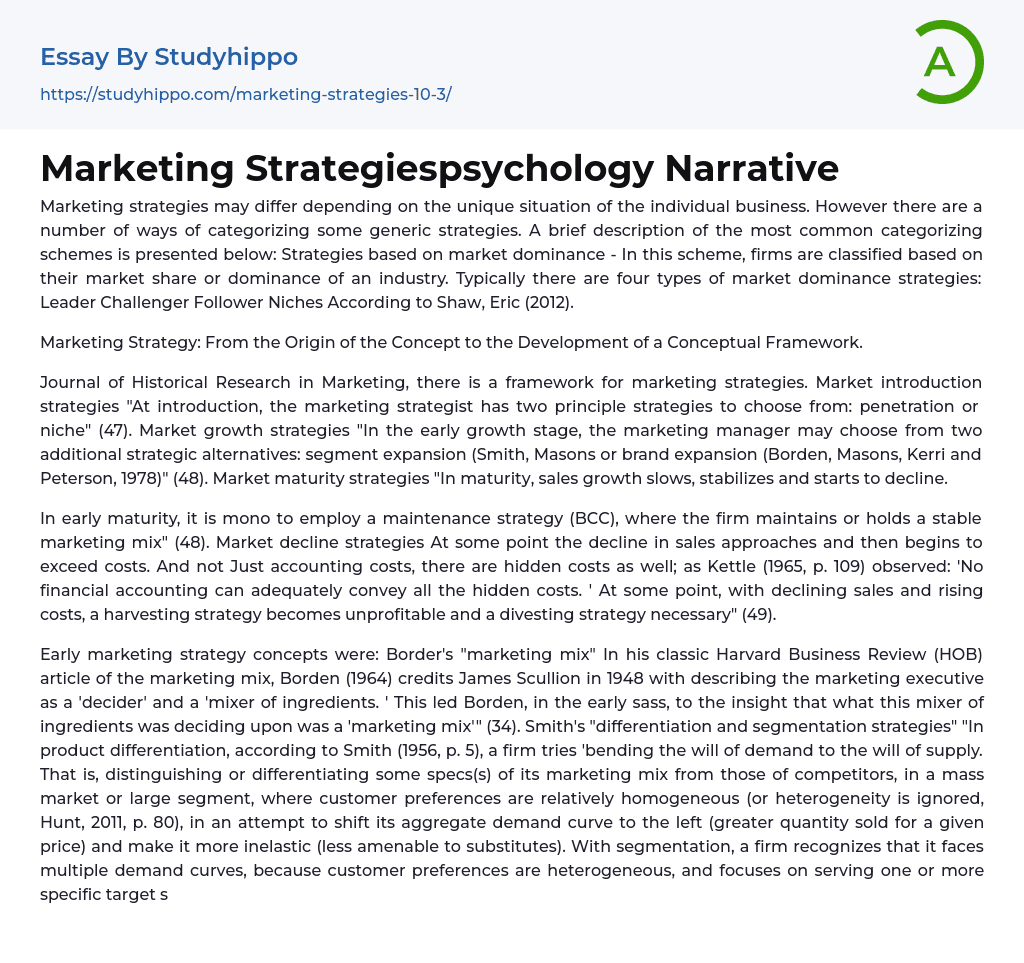Various businesses have distinct marketing strategies that are tailored to their specific circumstances. Nevertheless, there exist several ways to classify general strategies. Presented below is a concise explanation of the most prevalent categorization schemes:
Categorization based on market dominance: These strategies segment companies according to their market share or dominant position in an industry. Typically, there are four types of market dominance strategies: leader, challenger, follower, and niches (as outlined by Shaw, Eric in 2012).
The marketing strategy involves both the inception of the idea and the creation of a conceptual framework.
The Journal of Historical Research in Marketing provides a framework for marketing strategies. In the market introduction stage, marketers can choose between penetration or niche strategies (47). In the early growth stage, there are two other strategic options: segment expansion (Smit
...h, Masons) or brand expansion (Borden, Masons, Kerri and Peterson, 1978) (48). As the market matures, sales growth slows down, stabilizes, and eventually declines.
In early maturity, it is advisable to utilize a maintenance strategy (BCC) in which the company maintains a stable marketing mix (48). When sales decline and surpass costs, market decline strategies become relevant. These costs include hidden costs that cannot be accurately reflected through financial accounting alone, as stated by Kettle (1965, p. 109). As sales continue to decline and costs increase, a harvesting strategy becomes unprofitable and a divesting strategy becomes necessary (49).
Early marketing strategy concepts included Border's "marketing mix" and Smith's "differentiation and segmentation strategies". In Borden's article, he credits James Scullion in 1948 with describing the marketing executive as a 'decider' and 'mixer of ingredients'. This led Borden to realize that the marketing executive
was deciding on a 'marketing mix' in the early sass. Smith emphasized the importance of product differentiation in bending the demand to the will of supply, by differentiating certain aspects of the marketing mix from competitors in a mass market or large segment. This is done to shift the aggregate demand curve and make it less amenable to substitutes. Additionally, Smith discussed segmentation strategy which recognizes that a firm faces multiple demand curves due to customer preferences being heterogeneous. The firm focuses on serving specific target segments within the overall market.
Dean discusses two pricing strategies: skimming and penetration. Skimming involves introducing a product at a high price and then gradually lowering the price to attract different segments of the market. On the other hand, penetration pricing involves keeping the initial low price to quickly capture sales and market share, although with lower profit margins compared to skimming (37). Forester's "Product Life Cycle (PAL)" does not provide specific marketing strategies, but it offers a framework to choose from different strategic alternatives (38).
The text discusses various corporate strategy concepts, including Andrews' "SOOT analysis" and Nations' "growth strategies." The SOOT analysis, also known as TOWS analysis, was originally developed in the field of corporate strategy by Kenneth R. Andrews. Andrews is recognized for his contribution to the book "Business Policy: Text and Cases" (Learned et al., 1965) (41). Nations' growth strategies introduced the concept of "product-market," which involves analyzing the combination of new and existing products with new and existing markets using a two by two matrix (41-42). Porter's "generic strategies" focus on strategic scope and strategic strength. Strategic scope refers to market penetration, while strategic
strength refers to sustainable competitive advantage. Porter's generic strategy framework, presented in 1984, consists of two alternatives, each with two alternative scopes.
Both Differentiation and low-cost leadership have a dimension of Focus, which can be broad or narrow.
- Product differentiation
- Cost leadership
- Market segmentation
- Innovation strategies
- Pioneers
- Close followers
- Late followers
- Growth strategies
There are multiple ways to answer this question, but the most common approach presents four answers: Horizontal integration, Vertical integration, Diversification, and Intensification. These growth methods are known as organic growth. Horizontal growth happens when a company buys other businesses in the same industry, like a clothing retail store purchasing a food outlet. Both establishments belong to the retail industry, and their integration results in expansion. Vertical integration can be either forward or backward.
- Abnormal Psychology essays
- Social Psychology essays
- Developmental Psychology essays
- Jean Piaget essays
- Positive Psychology essays
- Classical Conditioning essays
- Counseling essays
- Psychoanalysis essays
- Educational Psychology essays
- Behaviorism essays
- Authority essays
- Operant Conditioning essays
- Maslow's Hierarchy Of Needs essays
- Mental Health essays
- Personality Psychology essays
- Psychotherapy essays
- Family Therapy essays
- Stanford Prison Experiment essays
- Abraham Maslow essays
- Erik Erikson essays
- Cognitive Psychology essays
- Sigmund Freud essays
- Attachment Theory essays
- Supersize Me essays
- Individual essays
- Infant essays
- Childhood essays
- Adolescence essays
- Growth Mindset essays
- Is Google Making Us Stupid essays
- Childhood Memory essays
- Positive Attitude essays
- Reinforcement essays
- Archetype essays
- Maturity essays
- Deception essays
- Certainty essays
- Conformity essays
- Aggression essays
- Behavior essays
- Human Behavior essays
- Obedience essays
- Adult essays
- Procrastination essays
- Morality essays
- Altruism essays
- Human Sexuality essays
- Role Model essays
- Perseverance essays
- Expressive essays




